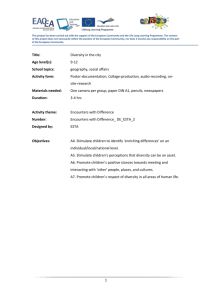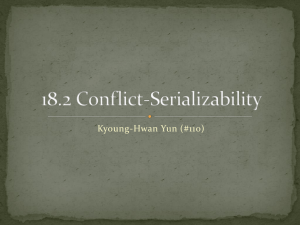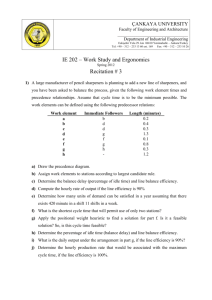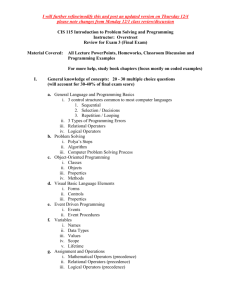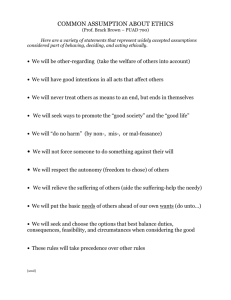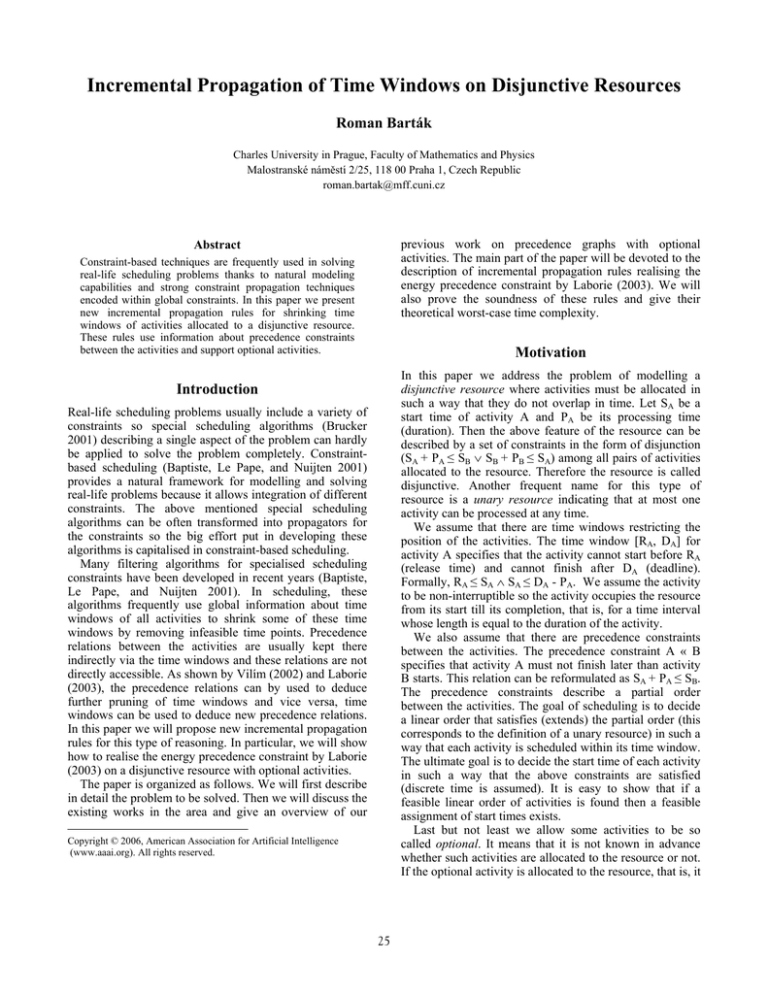
Incremental Propagation of Time Windows on Disjunctive Resources
Roman Barták
Charles University in Prague, Faculty of Mathematics and Physics
Malostranské náměstí 2/25, 118 00 Praha 1, Czech Republic
roman.bartak@mff.cuni.cz
previous work on precedence graphs with optional
activities. The main part of the paper will be devoted to the
description of incremental propagation rules realising the
energy precedence constraint by Laborie (2003). We will
also prove the soundness of these rules and give their
theoretical worst-case time complexity.
Abstract
Constraint-based techniques are frequently used in solving
real-life scheduling problems thanks to natural modeling
capabilities and strong constraint propagation techniques
encoded within global constraints. In this paper we present
new incremental propagation rules for shrinking time
windows of activities allocated to a disjunctive resource.
These rules use information about precedence constraints
between the activities and support optional activities.
Motivation
In this paper we address the problem of modelling a
disjunctive resource where activities must be allocated in
such a way that they do not overlap in time. Let SA be a
start time of activity A and PA be its processing time
(duration). Then the above feature of the resource can be
described by a set of constraints in the form of disjunction
(SA + PA ≤ SB ∨ SB + PB ≤ SA) among all pairs of activities
allocated to the resource. Therefore the resource is called
disjunctive. Another frequent name for this type of
resource is a unary resource indicating that at most one
activity can be processed at any time.
We assume that there are time windows restricting the
position of the activities. The time window [RA, DA] for
activity A specifies that the activity cannot start before RA
(release time) and cannot finish after DA (deadline).
Formally, RA ≤ SA ∧ SA ≤ DA - PA. We assume the activity
to be non-interruptible so the activity occupies the resource
from its start till its completion, that is, for a time interval
whose length is equal to the duration of the activity.
We also assume that there are precedence constraints
between the activities. The precedence constraint A « B
specifies that activity A must not finish later than activity
B starts. This relation can be reformulated as SA + PA ≤ SB.
The precedence constraints describe a partial order
between the activities. The goal of scheduling is to decide
a linear order that satisfies (extends) the partial order (this
corresponds to the definition of a unary resource) in such a
way that each activity is scheduled within its time window.
The ultimate goal is to decide the start time of each activity
in such a way that the above constraints are satisfied
(discrete time is assumed). It is easy to show that if a
feasible linear order of activities is found then a feasible
assignment of start times exists.
Last but not least we allow some activities to be so
called optional. It means that it is not known in advance
whether such activities are allocated to the resource or not.
If the optional activity is allocated to the resource, that is, it
Introduction
Real-life scheduling problems usually include a variety of
constraints so special scheduling algorithms (Brucker
2001) describing a single aspect of the problem can hardly
be applied to solve the problem completely. Constraintbased scheduling (Baptiste, Le Pape, and Nuijten 2001)
provides a natural framework for modelling and solving
real-life problems because it allows integration of different
constraints. The above mentioned special scheduling
algorithms can be often transformed into propagators for
the constraints so the big effort put in developing these
algorithms is capitalised in constraint-based scheduling.
Many filtering algorithms for specialised scheduling
constraints have been developed in recent years (Baptiste,
Le Pape, and Nuijten 2001). In scheduling, these
algorithms frequently use global information about time
windows of all activities to shrink some of these time
windows by removing infeasible time points. Precedence
relations between the activities are usually kept there
indirectly via the time windows and these relations are not
directly accessible. As shown by Vilím (2002) and Laborie
(2003), the precedence relations can by used to deduce
further pruning of time windows and vice versa, time
windows can be used to deduce new precedence relations.
In this paper we will propose new incremental propagation
rules for this type of reasoning. In particular, we will show
how to realise the energy precedence constraint by Laborie
(2003) on a disjunctive resource with optional activities.
The paper is organized as follows. We will first describe
in detail the problem to be solved. Then we will discuss the
existing works in the area and give an overview of our
Copyright © 2006, American Association for Artificial Intelligence
(www.aaai.org). All rights reserved.
25
is included in the final resource schedule then we call this
activity valid. If the activity is known not to be allocated to
the resource then we call the activity invalid. In other
cases, that is, the activity is not decided to be or not to be
allocated to the resource, we call the activity undecided.
Optional activities are useful for modelling alternative
resources for the activities (an optional activity is used for
each alternative resource and exactly one optional activity
becomes valid) or for modelling alternative processes to
accomplish a job (each process may consist of a different
set of activities).
Note that for the above defined problem of scheduling
with time windows it is known that deciding about an
existence of a feasible schedule is NP-hard in the strong
sense (Garey and Johnson 1979) even when no precedence
relations or optional activities are considered, so there is a
little hope even for a pseudo-polynomial solving
algorithm. Hence using propagation rules and constraint
satisfaction techniques is justified here.
global precedence graph where alternative resources
correspond to paths in the graph, but the graph is used
merely for cost-based filtering (optimization of makespan
or setup times).
In this paper we address the problem of integrated
filtering based on precedence relations and time windows.
From the beginning we assume the existence of optional
activities. A filtering algorithm for so called detectable
precedences with optional activities on a unary resource
has been proposed in (Vilím, Barták, and Čepek 2005).
This algorithm uses Θ-Λ-tree to achieve O(n.log n) time
complexity and it is a monolithic algorithm (must be
repeated completely if there is any change of domains).
This algorithm handles detectable precedences only and it
cannot accommodate precedences given from the external
world. The algorithm proposed in this paper can handle
any precedence relation.
The energy precedence constraint by Laborie (2003) can
compute new bounds for time windows from arbitrary
precedences and can discover new precedences from time
windows in reservoir type of resource. However, the
energy precedence constraint is not defined for optional
activities and the paper gave just the principles without
describing the filtering algorithm. Our propagation rules
extend the work by Laborie to optional activities and we
will present the rules in the implementation-friendly way
(the rules can be immediately transformed into a filtering
algorithm used by a constraint solver). To achieve this
goal, we use “light” data structures, namely domains of
variables, only. Moreover, the new rules are incremental so
they directly react to changes of particular domains rather
than running a monolithic algorithm from scratch. Such
rules are much easier for implementation and for
integration to existing constraint solvers. Our hope is that
their incremental nature will also lead to a good practical
efficiency.
Last but not least, there exists extensive literature on
temporal networks and among them the disjunctive
temporal networks (Stergiou and Koubarakis 1998) are the
closest approach to our proposal. The main difference of
our proposal from (most) works on temporal networks is
that we are not solving the temporal problem completely.
We propose a filtering algorithm that removes infeasible
values. This algorithm is expected to serve as a look-ahead
technique in the search frameworks solving the problem.
Moreover, we are not covering arbitrary disjunctive
temporal network but a specific one modelling a unary
resource. By borrowing the ides from scheduling of unary
resources we can achieve stronger domain pruning.
Finally, we assume optional activities that may or may not
appear in the network.
Related Works
Disjunctive resources are studied for a long time in
constraint-based scheduling (Baptiste, Le Pape, and
Nuijten 2001). There exist algorithms based for example
on edge-finding (Baptiste and Le Pape 1996) or notfirst/not-last (Torres and Lopez 1997) techniques that
restrict the time windows of the activities. Edge-finding
deduces that some activity must be processed before or
after some subset of activities, while not-first/not-last rules
deduce that some activity cannot be processed first or last
in a subset of activities. Other algorithms are based on
relative ordering of activities, for example filtering based
on optimistic and pessimistic resource profiles (Cesta and
Stella 1997). Recently, as scheduling and planning
technologies are coming together, filtering algorithms
combining filtering based on relative ordering and time
windows appeared. Detectable precedences by Vilím
(2002) are one of the first attempts for such a combination.
Laborie (2003) presents a similar rule called energy
precedence constraint for reservoir-like resources.
Filtering algorithms for scheduling constraints typically
assume that all the constrained activities will be included
in the final schedule. This is not always true, for example
assume that there are alternative processes to accomplish a
job or alternative resources per activity. These alternatives
are typically modelled using optional activities that may or
may not be included in the final schedule depending on
which process or resource is selected. The optional activity
may still participate in the constraints but it should not
influence other activities until it is known to be in the
schedule. This could be realised by allowing the duration
of the optional activity to be zero for time-windows based
filtering like edge-finding. However, this makes filtering
weaker and as shown in (Vilím, Barták, and Čepek 2005) a
stronger and faster filtering can be achieved if optional
activities are assumed in the filtering algorithm directly.
The paper (Focacci, Laborie, and Nuijten 2000) proposed a
Precedence Graphs
Our propagation rules that will be presented in the next
section require information about precedence relations
between the activities. This information is usually kept in a
precedence graph which is an acyclic directed graph where
26
nodes correspond to activities and there is an arc from A to
B if A « B. Moreover, we require fast access to every
predecessor and successor of each activity which can be
guaranteed if a transitive closure of the graph is kept.
Then, information about all predecessors and successors is
available in time O(1). The transitive closure of a
precedence graph with optional activities can be defined in
the following way.
MustBeBefore(A) = CanBeBefore(A) \ CanBeAfter(A)
MustBeAfter(A) = CanBeAfter(A) \ CanBeBefore(A)
Unknown(A) = CanBeBefore(A) ∩ CanBeAfter(A).
Note finally, that if an activity becomes invalid then it is
removed from the above sets of all valid and undecided
activities, which corresponds to removing the activity from
the precedence graph.
Definition 1: We say that a precedence graph G with
optional activities is transitively closed if for any two arcs
A to B and B to C such that B is a valid activity and A and
C are either valid or undecided activities there is also an
arc A to C in G.
CantBeBefore(A)
Unknown(A)
It is easy to prove that if there is a path from A to B such
that A and B are either valid or undecided and all inner
nodes in the path are valid then there is also an arc from A
to B in a transitively closed graph (by induction on the
path length). Hence, if no optional activity is used (all
activities are valid) then Definition 1 corresponds to a
standard definition of the transitive closure.
In (Barták and Čepek 2005), we proposed a double
precedence graph that models both standard precedence
relations and direct precedence relations. Briefly speaking,
the direct precedence between A and B means that A can
be directly before B, that is, there is no activity that must
be scheduled between A and B. We also proposed there a
constraint model for such double precedence graphs. This
model includes propagation rules for keeping the transitive
closure of the precedence graph as well as for keeping
information about direct precedence relations. The model
uses the following data structures to model precedence
relations (we will not use information about direct
precedence relations in this paper, hence we omit their
description). Each activity A has a variable ValidA attached
to it. If activity A is valid then ValidA = 1. If activity A is
invalid then ValidA = 0. If activity A is undecided then the
value of ValidA is not defined, in particular it is different
from 0 and 1 (in terms of constraint satisfaction, the
domain of ValidA for undecided activity A is {0,1}).
Information about precedence relations is accessible via
the following sets (« is a transitive closure of precedence
relations):
CanBeBefore(A) – activities that can be before A
(B ∈ CanBeBefore(A) ⇔ ¬ A « B)
CanBeAfter(A) – activities that can be after A
(B ∈ CanBeAfter(A) ⇔ ¬ B « A)
MustBeBefore(A) – activities that must be before A
(B ∈ MustBeBefore(A) ≡ B « A)
MustBeAfter(A) – activities that must be after A
(B ∈ MustBeAfter(A) ≡ A « B)
Unknown(A) – activities whose position relatively to
activity A is unknown
(B ∈ Unknown(A) ⇔ ¬ A « B ∧ ¬ B « A)
Sets MustBeBefore, MustBeAfter, and Unknown are used
just to simplify notation – these sets can be derived from
the other two sets in the following way (see also Figure 1):
MustBeAfter(A)
MustBeBefore(A)
A
CantBeAfter(A)
Figure 1. Representation of the precedence graph.
Propagating Time Windows
The standard constraint model for time allocation of the
activity assumes two variables – SA and EA – describing
when the activity A starts and finishes. If the processing
time PA of activity A is constant then the variable EA is not
necessary. However, we use this variable to simplify
notation used in the propagation rules. The position of
activity A in time is restricted by release time RA and
deadline DA that define a time window for processing the
activity. For a valid activity A, we define the initial domain
for the variable SA to be [RA, DA - PA] and, similarly, the
initial domain for the variable EA to be [RA + PA, DA]. For
an undecided activity A, we define the initial domain of SA
to be [RA, sup] and the initial domain for EA to be [inf, DA].
The reason is that an empty domain means failure in
constraint satisfaction, however, if the time window
becomes empty for an undecided activity then this activity
should become invalid instead of generating a failure.
Hence, we use unrestricted domains for undecided
activities and we will check emptiness of the time window
explicitly in the propagation rules. As soon as the activity
becomes valid, domains of time variables are restricted on
both sides.
The goal of time window filtering is to remove those
time points from the time window in which the activity
cannot be processed. Usually, only the lower and upper
bounds of the time window change, that is, the earliest start
time increases and the latest completion time decreases.
Notice that this information is kept for both valid and
undecided activities. We will use the following notation to
describe bounds of the above domains:
earliest start time
estA = min(SA)
latest start time
lstA = max(SA)
earliest completion time
ectA = min(EA)
latest completion time
lctA = max(EA)
27
If there is any change in the precedence graph like adding
a new arc or making some activity valid then the bounds of
time windows may be influenced because the sets Ω⟨X,A⟩
are changed. Also, if bounds of the time window for some
activity are changed then the above filtering rules should
also be recomputed. We will now present the propagation
rules realising the above-described incremental updates. To
prove soundness of these rules it is enough to verify that
all sets Ω⟨X,A⟩ that might be influenced by the change in the
precedence graph or in the time windows are explored.
This notation can be extended in a natural way to sets of
activities. Let Ω be a set of activities, then:
estΩ = min{estA | A∈Ω}
lstΩ = max{lstA | A∈Ω}
ectΩ = min{ectA | A∈Ω}
lctΩ = max{lctA | A∈Ω}
pΩ = ∑{pA | A∈Ω}
During propagation, we will be increasing est and
decreasing lct of activities which corresponds to shrinking
their time windows.
The earliest start time of activity A is influenced by the
activities that are processed before A. To be more specific
activity A must start after the earliest completion time of
any set of valid activities that must be processed before A.
This time can be formally expressed using the formula
max{estΩ + pΩ | Ω ⊆ {X | X « A ∧ ValidX = 1}}.
Similarly, the latest completion time of A is influenced by
the valid activities that must be processed after A. Hence,
we can use the following filtering rules to shrink the time
window of activity A:
estA ← max{estΩ + pΩ | Ω ⊆ {X | X « A ∧ ValidX = 1}}
lctA ← min{lctΩ - pΩ | Ω ⊆ {X | A « X ∧ ValidX = 1}}
Notice that only valid activities influence time windows of
other (non invalid) activities. This corresponds to our
requirement that undecided activities should not influence
other activities but they can be influenced. Hence, it may
happen that a time window for some undecided activity
becomes empty (or too small for the activity) which will
lead to invalidation of the activity.
The above two rules are special cases of the energy
precedence constraint (Laborie 2003) for unary resources.
We will now show how to compute these bounds in time
O(n.log n), where n is the number of activities. Let Ω’ be
the subset of the set {X | X « A ∧ ValidX = 1} with the
maximal estΩ’ + pΩ’ (the set Ω’ defines the new bound for
estA). Then Ω’ ⊇ {X | X « A ∧ ValidX = 1 ∧ estΩ’ ≤ estX},
because otherwise adding such X to Ω’ will increase pΩ’
and hence also estΩ’ + pΩ’. Consequently, it is enough to
explore sets Ω⟨X,A⟩ = {Y | Y « A ∧ ValidY = 1 ∧
estX ≤ estY} for each valid X that must be before A. In
particular, the new bound estA is computed using the
formula:
max{ estΩ⟨X,A⟩ + pΩ⟨X,A⟩ | X « A ∧ ValidX = 1 }.
This computation can be realised in time O(n.log n) using
the following algorithm. The new bound for estA is
computed in the variable end.
dur ← 0
end ← inf
for each Y∈{X | X « A ∧ ValidX = 1} in the nonincreasing order of estY do
dur ← dur + pY
end ← max(end, estY + dur)
We need time O(n.log n), where n is the number of
activities, to sort the activities and time O(n) for the loop.
The bound for lctA can be computed in a symmetrical way
in time O(n.log n).
Propagating Changes of Time Windows
Let us first describe propagation rules that are evoked
when the time window of some activity shrinks. If bounds
of a time window change then we can deduce several
conclusions. First, if the time window becomes too small
for the activity, formally estA + pA > lctA, then either
failure is detected, if activity A is valid, or undecided
activity A is made invalid. Second, time windows can be
used to deduce a new precedence between activities. In
particular, if estA + pA + pB > lctB then activity A cannot be
processed before activity B and hence we can deduce
B « A. This is called a detectable precedence in (Vilím
2002). Third, if the time window of valid activity A
changes then it influences time windows of activities
whose relative position to a given activity is known (they
are before or after the given activity).
Let us now focus on changes of time windows enforced
by an increase of the earliest start time of valid activity A
(a symmetrical deduction can be done for a decrease of the
latest completion time). Clearly, this increase may
influence earliest start time of all valid or undecided
activities B that must be after A. Recall that
estB ← max{ estΩ⟨X,B⟩ + pΩ⟨X,B⟩ | X « B ∧ ValidX = 1 } and
Ω⟨X,B⟩ = {Y | Y « B ∧ ValidY = 1 ∧ estX ≤ estY}. If estA
increases then estΩ⟨A,B⟩ increases as well and hence it may
define a new bound for estB. Moreover, if estA increases
then A may become a new member of some set Ω⟨C,B⟩, such
that estC ≤ estA and estA < estC, where estA is the original
value of estA. Hence pΩ⟨C,B⟩ will increase by pA and so it
may define a new bound for estB. Together, we need to
explore all sets Ω⟨X,B⟩ such that estX ≤ estA and estA < estX.
Note that it also includes the set Ω⟨A,B⟩. Also if estC = estA
and estA < estC then Ω⟨C,B⟩ = Ω⟨A,B⟩ so it is not necessary to
explore Ω⟨C,B⟩ separately. Finally, there is no other set
Ω⟨X,B⟩ that is influenced by the increase of the earliest start
time of activity A.
The following propagation rule /1/ reacts to increase of
the earliest start time. “estA is increased” is its trigger
meaning that the rule is invoked any time when estA is
increased. The part after is a propagator describing
pruning of domains. “exit” means that the constraint
represented by the propagation rule is entailed so the
propagator is not further invoked (its invocation does not
cause further domain pruning). “fail” means a failure so no
solution satisfying the constraints exists. We will use the
same notation in all propagation rules.
28
estA is increased
/1/
if ValidA = 0 then exit
else if estA + pA > lctA then
if ValidA = 1 then fail
else ValidA ← 0; exit
else
for each B∈Unknown(A) do
if estA + pA + pB > lctB then
add B«A
/* detectable precedence */
if ValidA = 1 then
ectA ← estA + pA
for each B∈MustBeAfter(A) do
dur ← ∑{pX | X « B ∧ estA ≤ estX ∧ ValidX = 1}
end ← estA + dur
for each Y∈{X | X « B ∧ ValidX = 1 ∧
estA < estX ∧ estX < estA }
in the non-increasing order of estY do
dur ← dur + pY
end ← max(end, estY + dur)
estB ← max(end, estB)
Symmetrically, rule /2/ updates lctB for activities B such
that B « A, if necessary. Recall, that lctA is the value of lctA
before the decrease. Together, the propagation rules /1/ and
/2/ incrementally maintain the energy precedence
constraint after changes of time windows.
and predecessors of a given activity or whether it is enough
to update just the direct predecessors and direct successors
and propagate the change through them. This will not
decrease the worst-case time complexity but, if possible, it
may improve practical time efficiency.
Propagating Changes in the Precedence Graph
The second group of propagation rules realises the energy
precedence constraint in an incremental way by reacting to
changes in the precedence graph. The rules are invoked by
making the activity valid or by adding a new precedence
relation.
Assume that some activity A becomes valid. Then, this
activity may influence other activities in the precedence
graph if their relative position to activity A is known. In
particular, if there is an activity B such that A « B then A
will become a member of sets Ω⟨X,B⟩ such that X « B,
ValidX = 1 and estX ≤ estA (this also includes a new set
Ω⟨A,B⟩). These sets are used to compute the earliest start
time of B and hence they should be re-explored. The other
sets Ω⟨X,B⟩ used to update estB have already been explored
or will be explored when calling the rules for some valid
activity in Ω⟨X,B⟩. A symmetrical analysis can be done for
activities B before A. The propagation rule /3/ realises the
above deduction.
/3/
ValidA is instantiated
if ValidA = 1 then
ectA ← estA + pA
lstA ← lctA – pA
for each B∈MustBeAfter(A) do
dur ← ∑{pX | X « B ∧ estA ≤ estX ∧ ValidX = 1}
end ← estA + dur
for each Y∈{X | X « B ∧ estX < estA ∧ ValidX = 1}
in the non-increasing order of estY do
dur ← dur + pY
end ← max(end, estY + dur)
estB ← max(end, estB)
for each B∈MustBeBefore(A) do
dur ← ∑{pX | B « X ∧ lctX ≤ lctA ∧ ValidX = 1}
start ← lctA – dur
for each Y∈{X | B « X ∧ lctA < lctX ∧ ValidX = 1}
in the non-decreasing order of lctY do
dur ← dur + pY
start ← min(start, lctY – dur)
lctB ← min(start, lctB)
exit
/2/
lctA is decreased
if ValidA = 0 then exit
else if estA + pA > lctA then
if ValidA = 1 then fail
else ValidA ← 0; exit
else
for each B∈Unknown(A) do
if estB + pB + pA > lctA then
add A«B
/* detectable precedence */
if ValidA = 1 then
lstA ← lctA – pA
for each B∈MustBeBefore(A) do
dur ← ∑{pX | B « X ∧ lctX ≤ lctA ∧ ValidX = 1}
start ← lctA – dur
for each Y∈{X | B « X ∧ ValidX = 1 ∧
lctX < lctA ∧ lctA < lctX }
in the non-decreasing order of lctY do
dur ← dur + pY
start ← min(start, lctY – dur)
lctB ← min(start, lctB)
Deduction similar to making an activity valid can be used
if a new arc, say A « B, is added to the precedence graph.
Note, than in such a case activities A and B are either valid
or undecided (neither A nor B is invalid). If A is valid
when A « B is added then A will become a member of sets
Ω⟨X,B⟩ such that X « B, ValidX = 1 and estX ≤ estA
(including a new set Ω⟨A,B⟩) and these sets must be reexplored to find out whether they lead to change of estB or
not. Note, that we are exploring only the influence of A to
B rather than exploring influence to all successors of B.
Time complexity of rules /1/ and /2/ is O(n2), where n is a
number of activities. We need time O(n.log n) to sort the
activities and time O(n2) to process the nested loops. Note
finally, that if the propagation rules change est or lct of
some activity then the propagation rules for these changes
are also invoked and so on (the above time complexity is
for a single run of the rule). This ensures that any change is
propagated through the precedence graph. The open
question is whether it is necessary to update all successors
29
This is because any successor C of B that is not yet a
successor of A will be explored when the arc A « C is
added to the graph by incremental maintenance of the
transitive closure as described in (Barták and Čepek 2005).
Similarly, if B is valid when arc A « B is added then we
must explore its possible influence on lctA. The above
deductions are realised by the propagation rule /4/.
to direct predecessors and successors of the activity while
still keeping the same filtering power.
Acknowledgements
The research is supported by the Czech Science
Foundation under the contract no. 201/04/1102. My thanks
go to Ondřej Čepek for proof-reading of the paper draft
and to anonymous reviewers for pointing my attention to
temporal networks.
A«B is added
/4/
if ValidA = 1 then
dur ← ∑{pX | X « B ∧ estA ≤ estX ∧ ValidX = 1}
end ← estA + dur
for each Y∈{X | X « B ∧ estX < estA ∧ ValidX = 1}
in the non-increasing order of estY do
dur ← dur + pY
end ← max(end, estY + dur)
estB ← max(end, estB)
if ValidB = 1 then
dur ← ∑{pX | A « X ∧ lctX ≤ lctB ∧ ValidX = 1}
start ← lctB – dur
for each Y∈{X | A « X ∧ lctB < lctX ∧ ValidX = 1}
in the non-decreasing order of lctY do
dur ← dur + pY
start ← min(start, lctY – dur)
lctA ← min(start, lctA)
exit
References
Baptiste, P., and Le Pape, C. 1996. Edge-finding constraint
propagation algorithms for disjunctive and cumulative
scheduling. In Proceedings of the Fifteenth Workshop of
the U.K. Planning Special Interest Group (PlanSIG).
Baptiste, P.; Le Pape, C.; and Nuijten, W. 2001.
Constraint-Based Scheduling: Applying Constraint
Programming to Scheduling Problems. Kluwer Academic
Publishers.
Barták, R., and Čepek, O. 2005. Double Precedence
Graphs. In Proceedings of the 24th Workshop of the UK
Planning and Scheduling Special Interest Group
(PlanSIG), 28–33. London: City University.
Brucker P. 2001. Scheduling Algorithms. Springer Verlag.
Cesta, A., and Stella, C. 1997. A Time and Resource
Problem for Planning Architectures. In Recent Advances in
AI Planning (ECP’97), 117–129. Springer Verlag.
Focacci, F.; Laborie, P.; and Nuijten, W. 2000. Solving
Scheduling Problems with Setup Times and Alternative
Resources. In Proceedings of AIPS 2000.
Garey, M. R., and Johnson, D. S. 1979. Computers and
Intractability: A Guide to the Theory of NP-Completeness.
W. H. Freeman and Company, San Francisco.
Laborie, P. 2003. Algorithms for propagating resource
constraints in AI planning and scheduling: Existing
approaches and new results. Artificial Intelligence 143:
151–188.
Stergiou, K., and Koubarakis, M. 1998. Backtracking
algorithms for disjunctions of temporal constraints. In
Proceedings of the 15th National Conference on Artificial
Intelligence (AAAI-98), 248–253. AAAI Press.
Torres, P., and Lopez, P. 1999. On Not-First/Not-Last
conditions in disjunctive scheduling. European Journal of
Operational Research 127: 332–343.
Vilím, P. 2002. Batch Processing with Sequence
Dependent Setup Times: New Results. In Proceedings of
the 4th Workshop of Constraint Programming for Decision
and Control, CPDC'02. Gliwice, Poland.
Vilím, P.; Barták, R.; and Čepek, O. 2005. Extension of
O(n.log n) filtering algorithms for the unary resource
constraint to optional activities. Constraints 10(4): 403–
425.
Let us now analyze the worst-case time complexity of the
above propagation rules. Time complexity of the
propagation rule /3/ is O(n2), where n is a number of
activities. We need time O(n.log n) to sort the activities
and time O(n2) to process the nested loops. Again, this
time complexity does not include invocation of rules /1/
and /2/ after changes of estB or lstB. Time complexity of the
propagation rule /4/ is O(n.log n), where n is a number of
activities. We need time O(n.log n) to sort the activities
and time O(n) to process the loops.
Conclusions
The main contribution of the paper is description of
filtering algorithms for incremental maintenance of energy
precedence constraint from (Laborie 2003) applied to a
disjunctive resource with optional activities. Rather than
proposing a monolithic algorithm, we focused on
incremental propagation of changes and on description of
rules in the form trigger-propagator that is used in existing
constraint solvers. We extended Laborie’s work by using
optional activities, we proved soundness of the proposed
propagation rules and we described their theoretical worstcase time complexity. We assumed fix duration of
activities but the propagation rules can be easily extended
to variable duration by assuming a minimal duration in the
presented rules and by adding a new rule reacting to the
increase of the minimal duration. There are still some open
questions concerning incrementality of the rules, namely,
whether it is possible to propagate some information only
30

